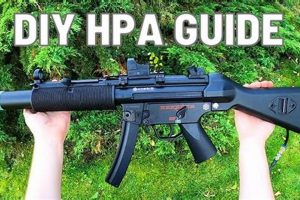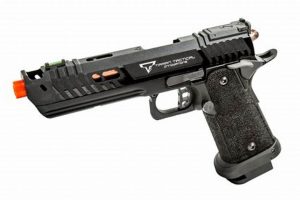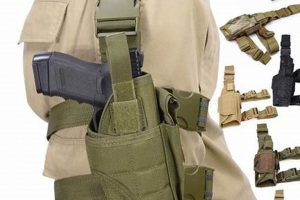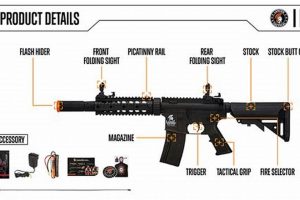The legality and permissibility of discharging airsoft weapons within public park spaces is a complex issue with variations dependent on local, state, and federal regulations. The activity involves using replica firearms that propel plastic projectiles, often in recreational simulations of tactical scenarios. Whether this activity is allowed hinges on a park’s specific ordinances concerning weapon discharge, public safety, and noise levels. The use of airsoft guns in a park could be considered unlawful if it violates established rules related to firearms, creates a public disturbance, or endangers park visitors.
Understanding the regulations is crucial for responsible airsoft enthusiasts. The activity’s potential for misinterpretation by the public, who may perceive airsoft guns as real firearms, necessitates adherence to all applicable laws. Further, the activity carries inherent risks; accidental injury to participants or bystanders and damage to park property represent potential negative consequences. Respecting these factors ensures the safety of all individuals sharing the park environment.
Therefore, before engaging in airsoft activities in a public park, one must thoroughly research and understand the park’s rules, local ordinances, and any applicable state or federal laws governing the use of airsoft guns. Direct contact with the park’s governing authority (e.g., park ranger, city council) is advisable to obtain clarification on permissible activities and to ensure compliance with all regulations. The following sections will explore specific legal considerations, safety guidelines, and best practices for airsoft activities in public spaces.
Essential Considerations for Airsoft Activities in Public Parks
The following tips provide vital guidance for individuals considering airsoft activities within public park environments. Adherence to these recommendations promotes safety, legality, and respect for the park’s community and resources.
Tip 1: Research Local Ordinances: Prior to engaging in any airsoft activity, meticulously investigate all applicable local ordinances regarding the discharge of airsoft weapons within public parks. Contact the park’s governing body or local law enforcement to clarify any ambiguities.
Tip 2: Adhere to State and Federal Laws: Ensure full compliance with state and federal regulations pertaining to airsoft guns. This may include laws regarding transportation, modification, and permissible locations for use. Ignorance of the law is not an acceptable defense.
Tip 3: Obtain Explicit Permission: Secure written permission from the park’s governing authority before commencing any airsoft activity. This documentation serves as proof of authorized use and mitigates potential legal issues.
Tip 4: Prioritize Safety Gear: Mandatory use of appropriate safety gear, including full-face masks, eye protection, and appropriate attire, is paramount. Enforce these regulations strictly among all participants to minimize the risk of injury.
Tip 5: Designate a Safe Playing Area: Confine airsoft activities to a designated area, clearly marked and separated from public thoroughfares and recreational spaces. Implement barriers or signage to prevent unintended pedestrian or animal entry.
Tip 6: Maintain Responsible Gun Handling: Practice responsible gun handling techniques at all times. This includes keeping airsoft guns unloaded when not in use, maintaining muzzle awareness, and avoiding reckless or unsafe firing practices.
Tip 7: Respect Park Property and Environment: Exercise utmost care to avoid damaging park property, vegetation, or wildlife. Collect all spent BBs and any other litter generated during the activity. Leave the park in the same or better condition than it was found.
By diligently following these guidelines, individuals can increase the likelihood of engaging in airsoft activities in public parks legally and safely, while minimizing the potential for negative impacts on the environment and community.
The subsequent sections will delve into specific legal challenges and explore strategies for fostering positive relationships with park authorities and the public.
1. Local Ordinances
Local ordinances serve as the primary regulatory mechanism governing the discharge of airsoft guns within park settings. These locally enacted laws define the specific restrictions and permissions applicable to airsoft activities, thereby directly influencing whether such activities are permissible.
- Definition of “Weapon” or “Firearm”
Municipal codes often contain a definition of what constitutes a “weapon” or “firearm.” If the definition is broad enough to encompass airsoft guns, even though they are not actual firearms, the ordinances regulating weapon discharge will apply. This inclusion can restrict or prohibit the use of airsoft guns in public parks.
- Restrictions on Discharge of Projectiles
Many local ordinances prohibit or restrict the discharge of any projectile within park boundaries, regardless of the type of projectile or device used. These restrictions are often in place to protect park visitors, wildlife, and property. Airsoft guns, by their nature, discharge projectiles, thereby potentially violating such ordinances.
- Noise Regulations
Local noise ordinances may also impact the use of airsoft guns in parks. The rapid firing of airsoft guns can generate noise levels that exceed permissible limits, particularly in residential areas adjacent to parks. Violations of noise ordinances can result in fines or other penalties.
- Designated Use Areas and Permitting Requirements
Some municipalities may designate specific areas within parks where certain activities, including airsoft, are permitted. These areas are typically subject to specific rules and regulations, including permitting requirements, safety protocols, and time restrictions. Failure to obtain the necessary permits or comply with the regulations can result in legal consequences.
The interplay of these local ordinances directly determines whether airsoft activities are legally permissible within a given park. Thorough research and consultation with local authorities are essential to ensure compliance with all applicable regulations. Ignorance of these ordinances does not constitute a valid defense against legal action.
2. Safety Regulations
The permissibility of engaging in airsoft activities within park environments is inextricably linked to adherence to stringent safety regulations. These regulations serve to mitigate the inherent risks associated with projectile-based activities and ensure the well-being of participants, bystanders, and the surrounding environment.
- Mandatory Use of Personal Protective Equipment (PPE)
The consistent and correct utilization of PPE, including full-face masks with impact-rated lenses, appropriate clothing covering exposed skin, and potentially gloves, is paramount. PPE acts as the first line of defense against projectile impacts, minimizing the risk of eye injuries, lacerations, and contusions. Failure to enforce mandatory PPE policies increases the likelihood of injury and corresponding legal liability.
- Velocity Limits and Projectile Type Restrictions
Airsoft gun velocity must be strictly controlled to minimize the potential for injury upon impact. Establishing and enforcing velocity limits, typically measured in feet per second (FPS) with 0.20g BBs, is critical. Furthermore, restrictions on projectile type, such as banning the use of metal or hardened plastic BBs, further enhance safety by reducing the severity of potential impacts. Chronograph testing should be conducted regularly to ensure compliance.
- Designated Safe Zones and No-Shoot Areas
Clearly defined and marked “safe zones,” where airsoft guns must be unloaded and have magazines removed, are essential for preventing accidental discharges and ensuring the safety of participants when not actively engaged in gameplay. Similarly, establishing “no-shoot areas,” such as public walkways, parking lots, and areas adjacent to sensitive habitats, prevents unintended projectile impacts on non-participants and protects the environment.
- Rules of Engagement and Responsible Conduct
Implementing and enforcing clear rules of engagement, including prohibiting blind firing, requiring verbal warnings before firing, and establishing minimum engagement distances, promotes responsible conduct and reduces the risk of accidental injuries. Emphasizing fair play, respect for other participants, and adherence to all safety guidelines fosters a culture of safety and minimizes the potential for conflict.
In summary, the allowance of airsoft activities within park spaces is contingent upon the rigorous implementation and enforcement of comprehensive safety regulations. Strict adherence to these guidelines minimizes the inherent risks associated with airsoft and ensures the safety and well-being of all individuals within the park environment. Absence of robust safety protocols significantly increases the potential for injury and legal ramifications, potentially leading to the prohibition of airsoft activities altogether.
3. Public Perception
Public perception profoundly influences the acceptability and, consequently, the permissibility of airsoft activities within public parks. The perception of airsoft guns, their users, and the overall activity directly impacts community support, regulatory scrutiny, and the ultimate decision of whether such activities are sanctioned.
- Misidentification with Real Firearms
Airsoft guns often bear a striking resemblance to real firearms, particularly to untrained observers. This visual similarity can trigger fear and alarm among park visitors who may misinterpret airsoft activities as a genuine threat. Reports of individuals brandishing what appear to be real weapons can lead to emergency calls, police intervention, and negative media coverage, ultimately undermining public support for airsoft in parks.
- Concerns About Safety and Injury
Even when individuals understand that airsoft guns are not lethal, concerns persist regarding the potential for injury. Projectiles, despite being plastic, can cause welts, bruises, and eye injuries. Public perception often exaggerates the risk of injury, leading to demands for stricter regulations or outright bans on airsoft activities in shared public spaces. Parents, in particular, may express concerns about the safety of their children in parks where airsoft is permitted.
- Disturbance and Noise Complaints
The simulated combat scenarios inherent in airsoft activities can generate significant noise, including the rapid firing of guns and tactical communications. Such noise can disrupt the peaceful enjoyment of the park by other visitors, leading to noise complaints and negative perceptions of airsoft users as inconsiderate or disruptive. This disruption can erode community support and prompt calls for greater regulation of airsoft activities.
- Impact on Park Image and Atmosphere
The presence of individuals dressed in tactical gear and engaging in simulated combat can alter the overall image and atmosphere of a public park. Some visitors may find such activities intimidating or inappropriate for a recreational space intended for relaxation and enjoyment of nature. A shift in public perception towards viewing parks as less safe or less welcoming due to airsoft activities can negatively impact park usage and community support for the park itself.
These facets of public perception highlight the crucial role they play in determining whether airsoft is deemed appropriate within public parks. Negative perceptions, driven by misidentification, safety concerns, disturbance, and altered park image, can lead to increased regulatory scrutiny, community opposition, and ultimately, the prohibition of airsoft activities. Proactive engagement with the public, coupled with responsible conduct and strict adherence to safety guidelines, is essential for fostering positive perceptions and ensuring the long-term viability of airsoft in public parks.
4. Designated Areas
The establishment of designated areas within public parks is a pivotal factor in determining the permissibility of airsoft activities. These designated zones represent a compromise, allowing the activity to occur while mitigating potential risks and disturbances to other park users and the environment. The presence or absence of such areas, and the regulations governing their use, are central to the question of whether airsoft guns can be used legally and responsibly in a given park.
- Containment of Activity
Designated areas confine airsoft activities to specific sections of the park, thereby minimizing the potential for interaction and conflict with other park users. This spatial separation reduces the risk of accidental projectile impacts on non-participants, protects sensitive environmental areas from disturbance, and concentrates noise within a limited zone. The size, location, and physical barriers of the designated area directly influence its effectiveness in containing the activity.
- Controlled Environment for Safety Regulations
Designated areas facilitate the enforcement of safety regulations specific to airsoft activities. By concentrating the activity in a defined space, park authorities can more easily monitor compliance with rules regarding protective gear, velocity limits, and rules of engagement. Signage, fencing, and designated entry/exit points can further reinforce safety protocols and prevent unauthorized access to the playing area.
- Facilitation of Permitting and Oversight
The designation of specific areas simplifies the permitting process for airsoft activities. Park authorities can require permits for the use of designated areas, allowing them to control the frequency, duration, and size of airsoft events. Permitting also enables authorities to collect fees to offset the costs of maintenance, monitoring, and potential damage to park property. Regular inspections of designated areas ensure compliance with permit conditions and identify any potential safety hazards.
- Promotion of Responsible Use and Community Integration
Designated areas can foster a sense of responsibility among airsoft participants by providing a dedicated space for their activities. This sense of ownership can encourage responsible behavior, adherence to park rules, and a commitment to maintaining the designated area in good condition. Properly managed designated areas can also serve as a platform for engaging with the broader community, educating the public about airsoft, and demonstrating responsible gun ownership.
In essence, the existence and management of designated areas are crucial determinants in the debate surrounding the use of airsoft guns in parks. When coupled with appropriate regulations, enforcement, and community engagement, these areas offer a viable solution for accommodating airsoft activities while preserving the safety, tranquility, and shared use of public park spaces. Conversely, the absence of designated areas often leads to unregulated activities, increased risk of conflict, and ultimately, the prohibition of airsoft guns within the park.
5. Liability Concerns
The question of whether airsoft guns can be discharged within a public park is inextricably linked to concerns regarding potential liability. The inherent risks associated with projectile-based activities necessitate careful consideration of legal responsibilities and potential financial repercussions stemming from accidents, injuries, or property damage.
- Negligence and Duty of Care
Individuals and organizations sponsoring or participating in airsoft activities in public parks assume a duty of care to ensure the safety of all individuals present, including participants, bystanders, and park staff. Failure to exercise reasonable care, resulting in foreseeable harm, constitutes negligence. Examples include inadequate supervision, failure to enforce safety regulations, or use of unsafe equipment. If negligence is proven, the responsible parties may be held liable for damages, including medical expenses, lost wages, and pain and suffering.
- Premises Liability
Park owners or operators have a legal obligation to maintain their premises in a reasonably safe condition. This obligation extends to identifying and mitigating potential hazards, including the risk of injury from airsoft activities. If a park owner is aware of airsoft activities occurring on their property and fails to take reasonable steps to prevent or regulate such activities, they may be held liable for injuries sustained by park visitors. This liability can extend to injuries caused by participants or spectators of an organized event.
- Inadequate Insurance Coverage
Many standard insurance policies may not provide adequate coverage for airsoft activities, particularly if they are conducted in a public park without proper authorization or permits. If an accident occurs, the responsible parties may be personally liable for damages exceeding the limits of their insurance coverage. Obtaining specific liability insurance tailored to airsoft activities is crucial for mitigating financial risks.
- Vicarious Liability
Organizations sponsoring or organizing airsoft events in public parks may be held vicariously liable for the negligent actions of their employees or volunteers. This means that the organization can be held responsible for the harm caused by individuals acting on its behalf, even if the organization itself was not directly negligent. Proper training, supervision, and background checks for employees and volunteers are essential for minimizing the risk of vicarious liability.
These liability concerns underscore the importance of proactive risk management strategies for anyone considering engaging in airsoft activities within a public park. Obtaining proper permits, implementing comprehensive safety protocols, securing adequate insurance coverage, and exercising due diligence in the selection and supervision of participants are all essential steps for mitigating potential liability and ensuring the safe and responsible conduct of airsoft activities.
Frequently Asked Questions Regarding Airsoft Gun Use in Parks
This section addresses common inquiries concerning the legality and appropriate conduct surrounding airsoft guns in public park settings, providing clarity based on typical regulations and safety considerations.
Question 1: Are airsoft guns classified as firearms under the law?
The classification of airsoft guns varies by jurisdiction. While they are generally not considered firearms under federal law, some state and local ordinances may define them as such, particularly if they closely resemble real firearms or are capable of causing significant bodily harm. It is essential to consult local regulations for a precise definition.
Question 2: What type of permit is required to operate airsoft guns in parks?
The permit requirements depend on the park’s governing body and local ordinances. Some parks may require a general park use permit, while others may necessitate a specialized permit for activities involving projectile weapons. Contacting the park’s administration or local law enforcement is necessary to determine the specific permit requirements.
Question 3: What are the standard safety regulations applicable to airsoft in public parks?
Typical safety regulations include mandatory use of full-face masks with impact-rated lenses, adherence to velocity limits (measured in feet per second), designation of safe zones and no-shoot areas, and adherence to established rules of engagement. These rules often prohibit blind firing and require verbal warnings prior to firing.
Question 4: What liabilities can arise from using airsoft guns in unauthorized park areas?
Using airsoft guns in unauthorized areas can result in significant liabilities, including charges for violating local ordinances, civil lawsuits for injuries or property damage, and potential criminal charges if the activity is deemed reckless or endangers public safety. The individual user is primarily liable, though event organizers may also bear responsibility.
Question 5: How is responsible airsoft conduct defined in a park environment?
Responsible conduct encompasses strict adherence to all safety regulations, respect for other park users and wildlife, avoidance of disruptive behavior (such as excessive noise), and proper disposal of all waste, including spent BBs. Furthermore, responsible airsoft participants communicate respectfully with park authorities and address any concerns promptly.
Question 6: What steps can be taken to foster positive community perception of airsoft in parks?
Promoting positive perceptions involves engaging in outreach programs to educate the public about airsoft safety and responsible practices, organizing park cleanup events, and demonstrating a commitment to minimizing noise and disruption. Building relationships with local community groups and park authorities is also essential.
Understanding the above information is crucial to responsible and legal airsoft activities. By familiarizing oneself with the local laws and guidelines, risks associated with airsoft in parks can be minimized. This understanding is a cornerstone of responsible airsoft practice and ensures that this hobby can be safely enjoyed within public spaces.
The following section provides resources for locating relevant local ordinances and guidance materials.
Conclusion
The exploration of whether airsoft guns can be discharged within a park environment reveals a multifaceted issue, contingent upon a confluence of legal, safety, and social considerations. Local ordinances, acting as the primary regulatory framework, delineate permissible activities, while stringent safety protocols mitigate inherent risks. Public perception, shaped by responsible conduct and clear communication, ultimately influences community acceptance. Designated areas, when implemented thoughtfully, offer a compromise, balancing the interests of airsoft enthusiasts and other park users. The specter of liability underscores the importance of comprehensive risk management and adherence to established guidelines.
In summation, the decision regarding the use of airsoft guns within parks is not a simple affirmative or negative determination. Instead, a responsible and informed approach, characterized by meticulous research, proactive engagement with authorities, and unwavering commitment to safety, is paramount. Prioritizing compliance with regulations and fostering positive relationships with the community will ultimately determine the viability of airsoft activities in public park spaces. The absence of such due diligence invites legal consequences, undermines public trust, and jeopardizes the long-term sustainability of this recreational pursuit within shared public resources.







